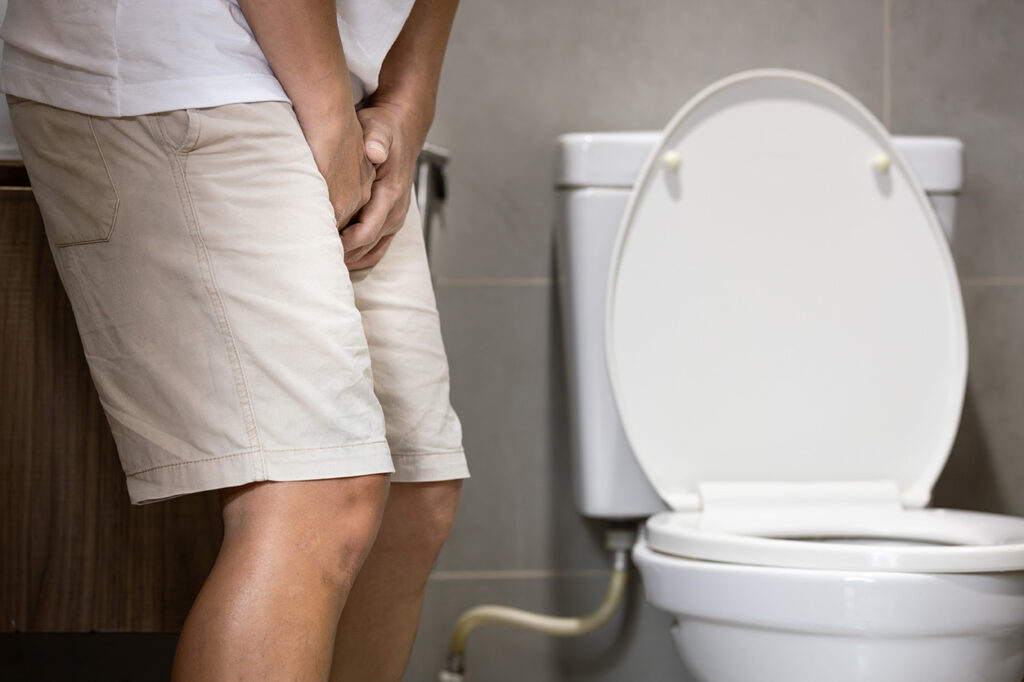Urinary incontinence (IU) and benign prostatic hyperplasia (BPH) are two common urogenital problems in men aged 45 and older.
If you have an enlarged prostate due to benign prostatic hyperplasia (BPH), you may experience uncomfortable or embarrassing lower urinary tract symptoms (LUTS) like urge or urinary incontinence.
But what is it, what causes it, how can you manage it, and what are effective BPH incontinence treatment options? Below, we share everything you need to know about managing BPH and incontinence.
Benign prostatic hyperplasia (BPH) is a noncancerous enlargement of the prostate gland. It can cause symptoms like difficulty starting urination, a weak urine stream, and the need to urinate frequently (especially at night).
The good news is it is treatable.

Urinary incontinence is a loss of bladder control, resulting in accidental and unintentional urine leakage.
It is a common and treatable symptom of BPH.
When your urinary tract functions optimally, your brain tell you to use the restroom when your bladder is partially filled. This advance warning ensures plenty of time to make it to the restroom. During urination, your urinary sphincter valve opens, and your bladder wall muscles contract, allowing your body to empty the bladder.
However, when you have BPH symptoms like incontinence, the system may break down for a variety of reasons.
BPH incontinence can cause issues such as:
Before seeking medical intervention for BPH incontinence, many men prefer to start with lifestyle interventions. These adjustments can help reduce urge incontinence and the risk of accidents before reaching the bathroom. Here are some suggestions to help manage incontinence due to BPH:
While these lifestyle measures can successfully reduce the daily impact of an overactive bladder, lasting relief for BPH incontinence can only be found by treating the enlarged prostate itself. Many men are discovering the benefits of PAE (Prostatic Artery Embolization) treatment for BPH.
PAE (prostate artery embolization) is a minimally invasive, non-surgical, interventional radiology procedure that provides effective enlarged prostate and incontinence treatment. PAE works by blocking the blood supply to specific areas of the prostate, causing those areas to shrink and relieve pressure on the urethra and bladder.
During the PAE procedure, our prostate specialists introduce embolic agents into the arteries that deliver blood supply to your enlarged prostate gland. This is achieved by inserting a small, narrow catheter into your body through a small incision is made near the groin. Guided by X-ray imaging, we can direct the catheter to target those arteries.
Once positioned properly, we can inject the catheter with an agent containing microscopic beads. These beads effectively block blood flow to the prostate, starving the gland of its nutrition and causing significant shrinking. As your prostate gland reduces in size, you will experience significant symptom relief. BPH incontinence should no longer be a major concern.
Our interventional radiologists perform PAE as an outpatient procedure, so you don’t have to worry about general anesthesia or overnight hospital stays. Plus, PAE is completed in about two hours, meaning most patients will go home on the same day as the procedure.
Following treatment, your recovery period should pass quickly. Most men who undergo PAE for BPH incontinence can resume regular activities within a week of their procedure.
Tired of being tied to the bathroom? Ready to find relief for incontinence and BPH?
We’re here to help. Request a consultation at the Georgia Prostate Institute today and begin your journey to urinary relief.

Atlanta
3225 Cumberland Blvd. Southeast, Suite 520
Atlanta, GA 30339
Stockbridge
1035 Southcrest Dr., Suite 220 + 250
Stockbridge, GA 30281
Tucker
1975 Lakeside Pkwy., Suite 300
Tucker, GA 30084
Scheduling
Please contact our dedicated specialists to schedule a consultation today.
2025 Georgia Prostate Institute. All rights reserved. Website Design by Healthcare Success